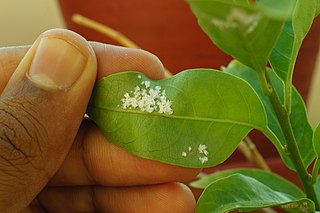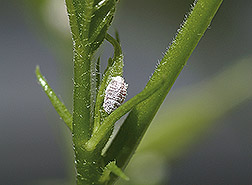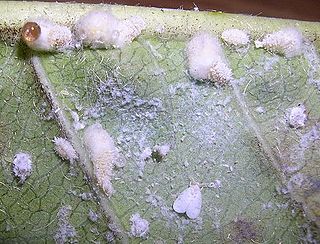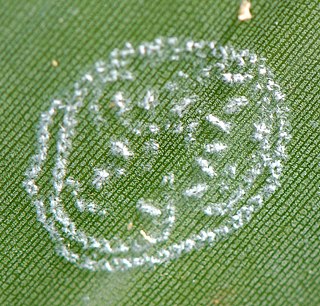
Mealybugs are insects in the family Pseudococcidae, unarmored scale insects found in moist, warm habitats. Many species are considered pests as they feed on plant juices of greenhouse plants, house plants and subtropical trees and also act as a vector for several plant diseases. Some ants live in symbiotic relationships with them, protecting them from predators and feeding off the honeydew which they excrete.

Scale insects are small insects of the order Hemiptera, suborder Sternorrhyncha. Of dramatically variable appearance and extreme sexual dimorphism, they comprise the infraorder Coccomorpha which is considered a more convenient grouping than the superfamily Coccoidea due to taxonomic uncertainties. Adult females typically have soft bodies and no limbs, and are concealed underneath domed scales, extruding quantities of wax for protection. Some species are hermaphroditic, with a combined ovotestis instead of separate ovaries and testes. Males, in the species where they occur, have legs and sometimes wings, and resemble small flies. Scale insects are herbivores, piercing plant tissues with their mouthparts and remaining in one place, feeding on sap. The excess fluid they imbibe is secreted as honeydew on which sooty mold tends to grow. The insects often have a mutualistic relationship with ants, which feed on the honeydew and protect them from predators. There are about 8,000 described species.

Woolly aphids are sap-sucking insects that produce a filamentous waxy white covering which resembles cotton or wool. The adults are winged and move to new locations where they lay egg masses. The nymphs often form large cottony masses on twigs, for protection from predators.

Withania somnifera, known commonly as ashwagandha or winter cherry, is an evergreen shrub in the Solanaceae or nightshade family that grows in India, the Middle East, and parts of Africa. Several other species in the genus Withania are morphologically similar.

Treehoppers and thorn bugs are members of the family Membracidae, a group of insects related to the cicadas and the leafhoppers. About 3,200 species of treehoppers in over 400 genera are known. They are found on all continents except Antarctica; only five species are known from Europe. Individual treehoppers usually live for only a few months.

Maconellicoccus hirsutus, is a pest of many plants, trees, and shrubs. It infests hibiscus, citrus, coffee, sugar cane, annonas, plums, guava, mango, okra, sorrel, teak, mora, pigeon pea, peanut, grapevine, maize, asparagus, chrysanthemum, beans, cotton, soybean, cocoa, and many other plants. The pest forms colonies on the host plant, and if left undisturbed, the colonies will grow into large masses of white waxy coverings on branches, fruiting structures, leaves, and even whole plants, including large trees.

Pseudococcus viburni is a close relative of the grape mealybug and a pest of the vineyards around the world.

Paracoccus marginatus, commonly known as the papaya mealybug, is a small sap-sucking insect in the mealybug family, Pseudococcidae. It is found on a number of different hosts, including economically important tropical fruit trees and various ornamental plants.

Planococcus citri, commonly known as the citrus mealybug, is a species of mealybugs native to Asia. It has been introduced to the rest of the world, including Europe, the Americas, and Oceania, as an agricultural pest. It is associated with citrus, but it attacks a wide range of crop plants, ornamental plants, and wild flora.

Aleurodicus dispersus, the spiralling whitefly, is a species of small, white sap-sucking insect, a true bug in the order Hemiptera. It originated in Central America and the Caribbean region and has spread to many of the world's tropical and subtropical regions, where it has become a major pest of agricultural crops.

Aphis craccivora, variously known as the cowpea aphid, groundnut aphid or black legume aphid, is a true bug in the family Aphididae. Originally of probable Palearctic origin, it is now an invasive species of cosmopolitan distribution.

Coccus hesperidum is a soft scale insect in the family Coccidae with a wide host range. It is commonly known as brown soft scale. It has a cosmopolitan distribution and feeds on many different host plants. It is an agricultural pest, particularly of citrus and commercial greenhouse crops.

Eriosoma lanigerum, the woolly apple aphid, woolly aphid or American blight, is an aphid in the superfamily Aphidoidea in the order Hemiptera. It is a true bug and sucks sap from plants.

Saissetia coffeae, known generally as hemispherical scale, is a species of soft scale insect in the family Coccidae. Other common names include the helmet scale and coffee brown scale.
Rhynocoris longifrons is a species of assassin bug in the family Reduviidae. It is a predator of other insects and is found in Asia. Crops on which it is found feeding on pests include pigeon pea, cardamom and peanuts. The insects are potentially useful in biological control because they are more resistant to pesticides than are the pests they consume.
Pyrilla perpusilla, commonly known as the sugarcane planthopper, is a planthopper in the family Lophopidae. It is native to Asia where it feeds on grasses and other plants and is a major pest of sugarcane and sorghum.
Amrasca biguttula, commonly known as the cotton jassid, is a subspecies of leafhopper belonging to the subfamily Typhlocybinae of family Cicadellidae. It is a pest of cotton, okra, and other crops in southern Asia and West Africa.
Geococcus coffeae is a species in the mealybug family, Pseudococcidae, commonly known as the coffee root mealybug, or brown scale. It lives underground where it inserts its mouthparts into roots and sucks the sap.

Harmonia octomaculata is a species of ladybird of the family Coccinellidae. It is found throughout India, Pakistan, Nepal, Bangladesh, Sri Lanka, Micronesia, and Australia.

Ceroplastes ceriferus, the Indian wax scale, is a species of scale insect in the family Coccidae. It is native to southern Asia and has spread to many other parts of the world.
















